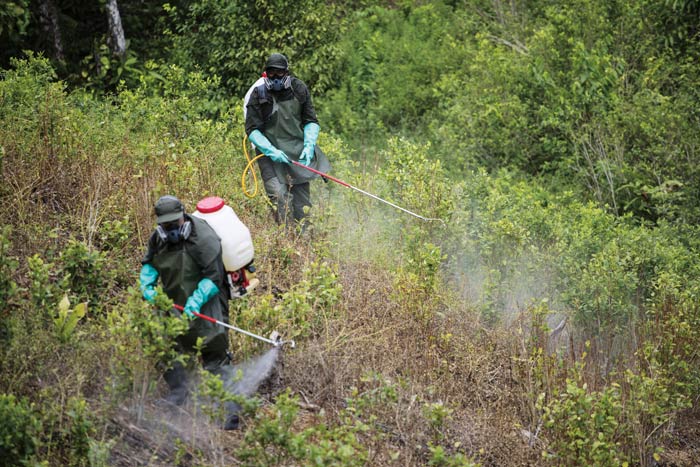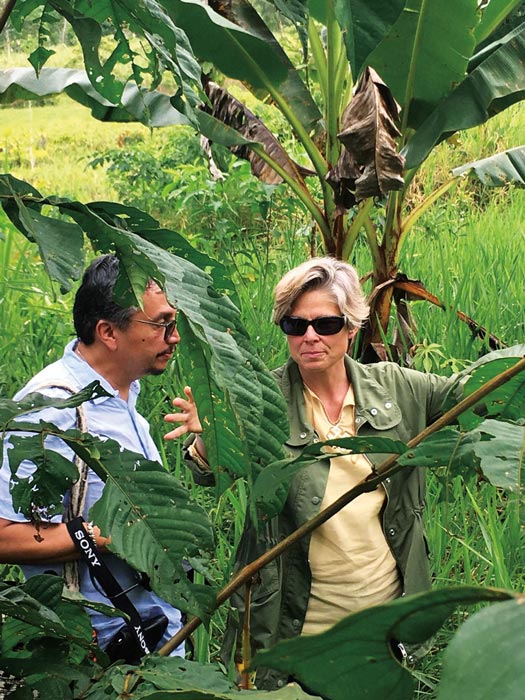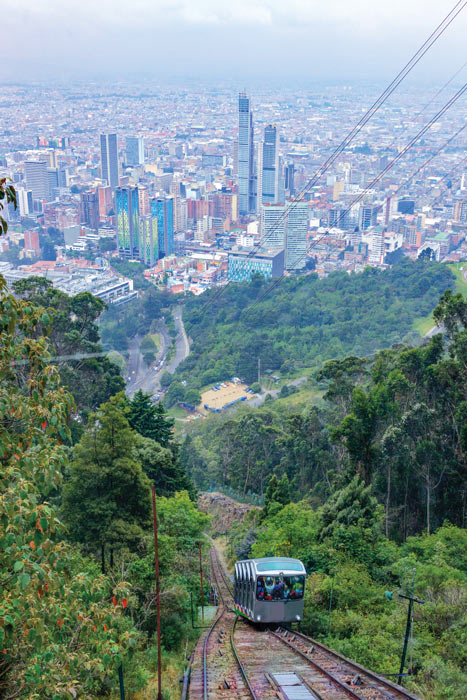THE MAGICAL REALISM OF COLOMBIA
By | Spring 2022
Although she tried to hide it under a kerchief, widow Heliadora’s hair was patchy. Visiting her mud-walled jungle home on my second visit to Colombia in 2019, I could guess why. Heliadora grew coca.
 The Colombian government had recently spent billions of dollars spraying intense chemicals in this part of the country to eradicate it. The herbicides killed coca, along with everything else, and also caused health effects to humans like hair loss.
The Colombian government had recently spent billions of dollars spraying intense chemicals in this part of the country to eradicate it. The herbicides killed coca, along with everything else, and also caused health effects to humans like hair loss.
Heliadora and her three children tried to control what they could under the circumstances. She kept their little hut immaculate, sweeping any stray clump from the dirt floor. Narco traffickers came directly to her door to buy the coca leaves. They paid in cash. I could smell the rice and beans she bought with that money, and saw the portion of metal roof it enabled her to put on over the thatch covering the rest of her home.
Still, Heliadora told me she hated living in the shadows, feeling fear, thinking the daughter of a cocalera like her could never marry a respectable boy. Heliadora wanted out of coca. She just couldn’t see a way. I asked to see her land — a plot of less than two acres. My boots sank in the crazy-fertile mud, where the light green coca plants poked up to toddler height among the darker greens of jungle growth.
This experience was much different than my first disorienting visit to the country in October 2018. At the time, Colombia felt contradictory, elusive, ambiguous to me.
Searching for perspective, I finally grasped a fleeting intuition for Colombia from her native son, Nobel Prize winning author Gabriel García Márquez. For García Márquez is the master of magical realism.
Through One Hundred Years of Solitude and Chronicle of a Death Foretold, García Márquez tells stories backward and upside down. As the author’s life philosophy was described in his biography: “What matters in life is not what happens to you but what you remember and how you remember it.”
This insight helped me understand a Colombia of layered realities rather than a coherent picture. Indeed, at times it feels that no two Colombians see their country the same way. Even though they reside in the same cities, mountains, jungles and beaches, each lives in a Colombia of their own creation.
Research on the Frontlines
It hit me as I walked the fields: Transitioning cocaleros like Heliadora out of coca wasn’t a law-and-order problem, or even an aid problem. Heliadora faced a business problem. Even if an NGO trained her to cultivate new crops, she’d miss months of income while they grew. And she didn’t have a market or guaranteed customers to sell her legal crops, or a way to transport them. She needed bridges across the risk — bridges both in income and to markets. This was a business problem our Meyer Business on the Frontlines (BOTFL) team could help with.
 Learning how to better rebuild societies damaged by conflict, prejudice, poverty and illicit economies is one of the great challenges of the 21st century. Doing so with a good heart and a focus on inherent dignity is the best place to start. BOTFL seeks to imagine new solutions to some of the world’s most challenging problems and to become a forum for all organizations committed to improvement, no matter how disparate, to work together to build stable and prosperous communities.
Learning how to better rebuild societies damaged by conflict, prejudice, poverty and illicit economies is one of the great challenges of the 21st century. Doing so with a good heart and a focus on inherent dignity is the best place to start. BOTFL seeks to imagine new solutions to some of the world’s most challenging problems and to become a forum for all organizations committed to improvement, no matter how disparate, to work together to build stable and prosperous communities.
The question became: How does our BOTFL team, working with a terrific local partner PASO Colombia (Paz Sostenible para Colombia, translated as Sustainable Peace for Colombia), develop a path for cocaleras such as Heliadora to learn to grow new crops and then create markets in which to sell those products?
In 2019, Heliadora helped fellow coca growers form a farmers’ cooperative. She signed up for four months of leadership training in running that cooperative. PASO Colombia, which works toward inclusive rural development as a key to sustained peace after decades of civil war, paid her during that time. She planted lemon trees, learned to grow pumpkins and other vegetables, and helped launch markets in a nearby town for poor farmers known as campesinos.
Although she took an initial 30% financial hit, with every successful market, she’s building back to her previous income levels. Her three children are still in school, and most importantly, she feels safer and happier. We’re now expanding this model’s reach from the original cocaleros to many more.
The next question became: Could this model be tested through rigorous research methods to determine if it really could be effective at a much larger scale? A lot of coca and opium substitution programs have failed. Back on campus, we walked across the quad to visit our friends in the College of Arts and Letters — Joe Kaboski, the David F. and Erin M. Seng Foundation Professor of Economics, and Wyatt Brooks, formerly of Notre Dame. It took Joe and Wyatt about a nanosecond to agree to join our effort. Together with our BOTFL partners and the PASO Colombia staff who flew in for a three-day planning meeting, we developed the research program. We had an idea and a plan.
If PASO’s program could combine agricultural training and market creation, we believed that cocaleras would shift some of the cultivation toward legal crops and away from coca while sustaining their incomes because we would reduce the risk of that path. What differentiated our program from many similar agriculture extension initiatives was its focus on commercialization of new crops, and on the creation of viable markets and sustainable businesses.
The plan was an audacious one. We would recruit 1,800 coca-growing families across an entire province of Guaviare in the Colombian Amazon to participate in the study. Holding all other variables constant, we would randomize which families in various counties would be a part of the PASO program and which would be the controls. We would even recruit locals to conduct all of our baseline surveys.
To measure how well the program was doing, we would track income per family through a series of surveys. None of us expected the cocaleros to tell us truthfully about their coca cultivation, so we registered the GPS coordinates for the cocalera households and used American satellites, which can accurately report vegetation down to squares measuring 500 feet by 500 feet, to track coca growing over time.
In an age of calamity and persistent problems, you don’t often hear about success stories.
Conceptually simple. Fiendishly difficult to implement: Guaviare
The first thing that hits you is the wall of heat and humidity. By 8 a.m., the temperature had already climbed to 80 degrees when we disembarked from our Sabena flight onto the tarmac at San José del Guaviare’s tiny airport. Flowering plants grow on shrubs which grow on trees making the jungle dense with oxygen and energy.
Guaviare is a wild department in Colombia’s Amazon — full of jungles and mountains. Surrounded by dense vegetation, the runway to its tiny airport is so short that our Sabena flight had to turn back and return to Bogota once already. The first time we tried to land, the low cloud cover and driving rain — characteristic weather conditions for Guaviare — obscured visibility to the point the pilot couldn’t see to land. Fortunately, the pilot attempted a second time a few hours later and was successful. We were met by what seemed like the whole town for such a big, twice-a-week event.
Long ignored by the government in Bogota, Guaviare possesses all the symptoms of neglect: non-existent infrastructure, poor communications, massive poverty, isolation and violence. For nearly 50 years, the Revolutionary Armed Forces of Colombia — or FARC, a violent guerrilla group — controlled this territory. In the 1970s, newly introduced coca cultivation attracted poor settlers as coca fever spread.
Although not native to the Amazon, coca spread unchecked in the jungle and soon the Medellín drug cartel moved in to control cocaine processing in the region. By the 1990s, both the FARC and paramilitary groups financed the horrors of their ongoing violence through the buying and selling of coca and cocaine. Barter exchanges among the campesinos were replaced; transactions in the region now used the common currency of coca paste. Suddenly neighbors had something to hide from each other.
The poverty even surprised experienced development economist Joe Kaboski, as it was far worse than what he saw in Sub-Saharan Africa. Families gathered firewood to cook over open flames outdoors. There were no shoes for kids, no sanitation. Many folks barely had a primary education. Farmers took produce to markets by pickup truck on cow paths or by kayaks along the Amazon’s tributaries.
And the conflict is never far from Guaviare. Recently, a United Nations convoy was attacked, the vehicles burned, right by the roadside café where our joint research team had eaten in September 2021. Fortunately, the UN staff escaped. However, our local partners must remain ever vigilant and careful. Coca grows in these areas due to very limited state rule of law. Yet this was our mission, to work with the very brave former cocalero communities scattered across Guaviare in order to test whether we could develop a path away from the scourge of coca.
Bringing Business to the Frontlines
Who should be called on to solve the world’s thorniest development challenges, such as extreme poverty and rebuilding society after war? Many people think of governments, militaries and NGOs. But based on our BOTFL research and experiences developing more than 70 growth-driven solutions in 30 countries, we have come to believe that business is indispensable. That’s because business and markets create jobs and opportunities, which foster both individual dignity and community stability.
 The past few decades have proven that aid alone cannot stop poverty and conflict. Since the 1960s, rich countries have shoveled trillions to poorer ones, often with generous intentions. Major foundations have tried the same. Two decades ago, the famously vocal economist Jeffrey Sachs called for “the end of poverty,” arguing that for the price of a cup of coffee for each person in a wealthy society, the developing world could be lifted onto the bottom rungs of the development ladder. Yet his Millennium Villages project failed, all but collapsing within 10 years.
The past few decades have proven that aid alone cannot stop poverty and conflict. Since the 1960s, rich countries have shoveled trillions to poorer ones, often with generous intentions. Major foundations have tried the same. Two decades ago, the famously vocal economist Jeffrey Sachs called for “the end of poverty,” arguing that for the price of a cup of coffee for each person in a wealthy society, the developing world could be lifted onto the bottom rungs of the development ladder. Yet his Millennium Villages project failed, all but collapsing within 10 years.
More recently, capable NGOs such as the Gates Foundation and Acumen Fund have made progress, especially by fostering entrepreneurship. But even that approach has hit limits with these most stubborn human problems, particularly when shifting risk to the poorest of the poor.
Collectively, American society — and indeed, the world — is at a moment of reevaluating capitalism. Famous economists’ defenses of the profit-seeking system fill books whose subtitles reference Hard Times, New Anxieties and A World on Fire. There’s a reason for attack: The top eight richest billionaires own as much combined wealth as half the human race.
Capitalism is the most successful economic system the world has ever known. Yet its edges can be jagged; its teeth, mawing. Despite the prosperity it has built for millions, it has still left more than one in eight human beings mired in violent conflict, deep poverty, disease and stagnation; a portion of the global population that Oxford economist Paul Collier memorably coined “the bottom billion” in his breakout 2007 bestseller of the same name.
So with such inequality, shouldn’t we argue that part of the answer is to turn against the corporations and individual profit-makers to ease conflict and poverty? Working with some of the world’s most vulnerable and oppressed, we can appreciate the skepticism. But during a post-Oxford decade at McKinsey & Company, I saw the dynamism of the private sector up close. Incentivized to make money, organized to be ruthlessly pragmatic, business simply gets work done. At every level — streetside vendors, mid-size olive oil producers or multinational corporations — producers and sellers are dynamic.
We can harness business’ power to create the jobs that men need to resist being recruited to take up arms, and the opportunities that women need to move away from illicit crops to make gains for their families on education, health and livelihoods. We can use capitalism’s techniques to help people build local businesses that last, and give them the dignity of selling a product, performing a service or doing work that others find valuable rather than having to depend on the unreliable aid handout.
Aid can’t last forever. Governments have limits. Militaries alone can’t stabilize societies whose members are so hopeless about their futures that they turn to violence. The successes have come, we’ve found, when we’ve fostered real collaboration between business and the public and philanthropic sectors. This leads to solutions that are unconventional, creative and sustainable over time. Cross-sector partnerships aren’t easy, and leaders of government, the military and nonprofits too often tend to stay in their lane (and tell us to stay in ours).
We think of the difference that the private sector can make in changing the prognosis for a place whose outlook seems grim. When pragmatic business thinking and durable markets are developed, they make gains that are profound — improving the lives of the world’s most vulnerable.
No way but forward
Colombia continues to instill a heavy heart and sense of foreboding. The country possesses incredible riches: fertile land that boasts three harvests a year, incredibly hard-working people, a peace agreement with honor negotiated across multiple vested interests. Yet it also faces the legacy of armed conflict, illegal economies, prejudice and poverty. We ask ourselves, from where might hope for a better future arise?
During a visit to Notre Dame in September 2019, two leaders of opposing political factions in Colombia engaged in a very public debate on the government and the peace process. Both advocated for their views passionately. Even with my limited Spanish, I intuitively felt there was very little common ground between their two positions.
Yet after the debate, something startling happened: Both shook hands and expressed genuine enthusiasm to return to Colombia and keep working for peace. Both saw a path forward.
From my visits to Colombia, I had perceived their society’s magical realism as a liability — as an inability or unwillingness to see the “facts on the ground.” Yet, I have come to believe that magical realism is actually a strength. Despite the odds, seeing a Colombia of their own imagination enables Colombians to persevere and continue working toward a better future.
Colombians rejoice in each small sign of progress as cause for hope. There is no other way but forward.

Comments